Austria at a Glance
Will vibrant Vienna put you in a whirl? Just how dreamy is the Danube? Are the hills really alive with the sound of music and the Mur Valley really that green? Are the lakeland views at Berchtesgaden’s Konigsee, Hallstatt and Traunkirchen really as breath-taking as they say?
We can’t give you all the answers, but we’d like to share some background to a few of our favourite amazing places included in our cycling holidays in Austria, including our famous Vienna bike tour.
Find out more about cycling in the Austrian Lake District, along the Danube and across Bavaria – from Munich to Salzburg
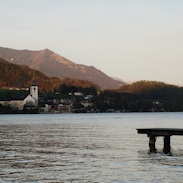
Abersee
Situated on the southern shore of the Lake Wolfgangsee between the two bigger towns of St. Gilgen and St. Wolfgang, this is a picturesque village with a modern church and pretty geranium strewn chalets. Abersee is often also used as a term to describe the whole Lake Wolfgangsee area in the Salzkammergut. ‘Aber’ comes from the local dialect word Aper (snowless) which means that this western part of the lake never freezes up, not even in the coldest of winters.
Bad Goisern
Officially a spa since the 1950s, this market town in the Salzkammergut of Upper Austria has a history going back to the 14th Century. St. Agatha’s church is slightly austere-looking, but crowned with a dome and clock – such a typical combination for the region. The place has won fame through the development of special mountain shoes (Goiserer Schuh).
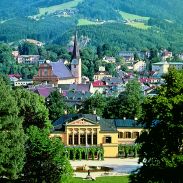 Bad Ischl
Bad Ischl
This well-located and picturesque spa town dating back to Roman times won fame as the summer residence of Emperor Franz Josef between 1849-1914. Today, ‘Seeauerhaus’ where he got engaged to Empress Elizabeth of Bavaria is now the town museum. The impressive Kaiservilla (Imperial Villa) was his wedding present from his mother, and so Bad ischl became his summer home. The town is quite cosmopolitan in feel, with old and new buildings brushing shoulders comfortably. It’s streets next to the church include the area’s oldest hotel, Hotel Zur Post.
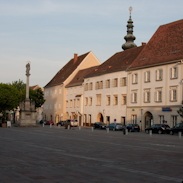 Bad Radkersburg/Gornja Radgona
Bad Radkersburg/Gornja Radgona
Amidst the thick woodlands of the Mur Valley in Southern Styria and Austria’s sunniest spot according to the records, this village doesn’t really have a castle – it is one! It sits proudly isolated in a historic sort of way, facing Oberradkersburg on the other side of the River Mur – part of Slovenia since 1919. Many of the medieval origins of this noble defensive outpost are masked by refinements: 15th and 16th C. houses ring the main square and the town hall with its ornate confection of a tower is late
Gothic/Baroque in style. The Herberstorff Renaissance Palace has a very Italianate courtyard arcade and medieval tower linked to the town fortifications. The town has nearby thermal springs and a thriving spa complex.
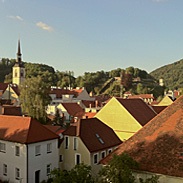 Bruck an der Mur
Bruck an der Mur
At the confluence of the Rivers Mur and Murz in Styria, this is a historic city rich from its mining past. The 15th C. Kornmesserhaus, built for a local iron merchant, steals pride of place on the main square and the exuberant facades here, as well as the elaborate iron canopy over the main well, all are testimony to a wealthy trading past. The Romanesque Ruprechtskirche contains ‘The Last Judgement’, one of Austria’s most complete and inspiring medieval frescos. The climb up the Schlossberg to the remains of castle Landskron is well worth the effort and rewards with some great views of the city and surrounding area.
Ebensee
One time primary production centre for salt in Austria, this little town is surrounded by three picturesque lakes: Traunsee, the largest of the three is used for boating; whilst Ofensee and Langbartsee are protected areas used for bathing only. An aerial tramway runs up to the summit of the Feuerhogel mountain and there is also a show cave to visit at Gasserhöhle.
Enns
Considered to be Austria’s oldest town – Enns’s history is particularly rich, as a Roman settlement and during the Magyar invasions (AD 900) when the ‘Castle Ennsegg’ (still an impressive fortress today) was built. The hallmark of the town is its proud city tower on the main square, bedecked with eagles, clocks, sundials and memorial plaques. It was built 1564-68 as a bell and watch tower.
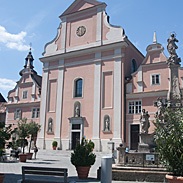 Frohnleiten
Frohnleiten
Known as ‘The Pearl of the River Mur’, this roadside village grew up from medieval market origins on a sweeping bend of the river near Graz in Styria. Burg Rabenstein, the 12th C. castle overhauled in the Baroque period perches above the village and is now a private domain. Frohnleiten boasts the fine 18th C. Church of the Assumption, which has a remarkable Rococo interior and the ‘Steirische Blumengarten’ – a beautiful public garden and a floral treat which is not-to-be-missed.
Gmunden
Located on the northern shore of the Traunsee in the southern part of Upper Austria, the city is particularly famous for its role in the salt trade and its ceramics which has a typical green-white pattern. A rather special holiday resort during the time of the Austro-Hungarian monarchy, the town is dotted with smart mansions and villa reminders.
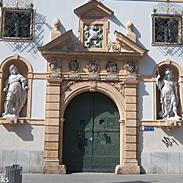 Graz
Graz
Capital of Styria and designated a UNESCO World Heritage Site – Graz is Austria’s second-largest city with six universities and divided into two parts by the River Mur. The historic inner city has survived intact, and the best view over the reddish brown roofscapes and onion-shaped belfries is from the top of the Schlossberg, a green hill with its landmark tower reached by a lift, funicular railway or 260 steps! Around the main square colourful facades hide intimate medieval courtyards and a maze of alleyways. The town hall is appropriately impressive and the cathedral beautifully Baroque in its decoration. Don’t miss the universe-inspired Schloss Eggenburg for Italianate elegance and sheer architectural eccentricity (4 towers, 365 windows,
24 staterooms). European Capital of Culture in 2003, Graz also has plenty of contemporary surprises too – from the space ship of Kunsthaus to a steel amphitheatre located mid-Mur and known locally as the ‘silver snail’.
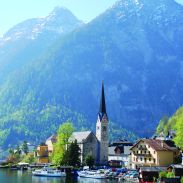 Hallstatt
Hallstatt
Sitting on the south-western shore of a beautiful lake, this picturesque little town with churches nestling in the mountainside is designated a World Heritage Site. Hallstatt is home to one of the earliest blacksmith sites and the world’s first known salt mine – ‘Hall’ is the old Celtic name for salt. This is located above the town and can be visited. Until the late 19th C. access to the town was only by boat or narrow mountain trails. Hallstatt is a very popular tourist centre best explored on foot.
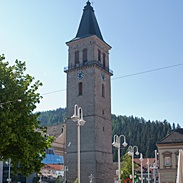 Judenburg
Judenburg
At the western end of the Aichfeld on the banks of the River Mur in Styria, this picturesque hill town was allowed to collect tolls and controlled the Mur Valley iron and lavender trade in the Middle Ages. Today, the town museum recounts the the local mining history; the town name suggests the large Jewish community in place here in the 13th C. The remains of the medieval castle on the banks of the Mur are worth exploring, whilst the impressive 75m Stadtturm (Town Tower) built in the 1400’s delivers stunning views. The medieval Magdalenakirche is renowned for its stained glass and frescos.
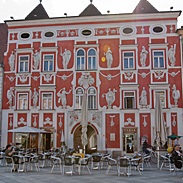 Leoben
Leoben
This university town on the River Mur is often referred to as ‘The Gateway to the Styrian Iron Road’. Local festivals still celebrate its rich mining past. The ‘Schwammerlturm’ or mushroom tower is iconic and on the 13th C. main square the red and white baroque facade of the Hackl Haus is particularly eye-catching.
St. Franz Xaver’s is one of the most significant Jesuit churches in Austria, whilst the Lutherian Church here is finely Art Nouveau in style. The Gösser Brewery Museum, situated next to the ancient convent, is a refreshing must.
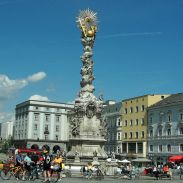 Linz
Linz
Named after the original Roman fortress (Lentia), Linz is the capital of Upper Austria and the country’s third largest city. A key trading position – in the 15th C. it was the most important city in the Habsburg Empire where Emperor Friedrich III had his residence. His castle is located near St. Martin’s, the oldest church in Austria, and the Pöstlingberg church on the hill is also well worth a visit. The main square is home to the golden memorial to victims of plagues past, and has a colourful and lively market. The city is an interesting fusion of old and new with symmetrical, classical facades matched with striking modern buildings such as the Ars Electronica – the museum of the future on the north bank of the Danube. On the south banks of the river, the Lentos is the new gallery for 20th and 21st C. art which is wonderfully lit up at night from the inside. Linz is well known for its musical treats – from Mozart to Anton Bruckner – and has a more notorious link as the city where Hitler went to school.
Krems
Historic city walls, an imposing city gate (the Steiner Tor), towering churches and plenty of shopping opportunities down narrow lanes – Krems is Austria’s fifth largest city situated on the confluence of the Krems and Danube Rivers at the eastern end of the Wachau Valley.
Maria Taferl
Located in the Nibelungengau in Lower Austria, this is the most important pilgrimage site in Austria and one which goes back many centuries. The name comes from ‘Holy Mother’. The first church here was built around a shrine and local legends tell of miracles which saved unfortunate woodcutters. The Basilica which you see today was designed by the same architect who created the nearby monastery at Melk. The flamboyant cupolas are matched by the exuberant baroque interior which drips with gold leaf and is decked with wonderful frescoes. The interior has recently undergone a major programme of restoration.
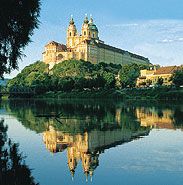 Melk
Melk
Situated next to the Wachau Valley along the Danube, the town is best known as the site of a massive baroque Benedictine monastery, Stift Melk. The monastery was founded on the site of a Babenberger castle in 1089 by King Leopold I, and like a number of other historic houses around the town is built on and into the rock above the Danube.
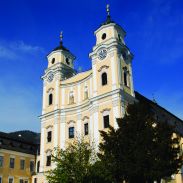 Mondsee
Mondsee
The village sits on the northern shore of a deep, privately-owned lake which is known as the warmest in the Salzkammergut. The lake is popular for water sports, but the main attraction for the tourist tends to be the cream and white Collegiate Church which was used in the wedding scenes of the classic film, The Sound of Music. The scenery around the lake is stunning, with the Drachenwand (Dragonwall), a rock wall on the southern shore of the lake, a particularly impressive sight.
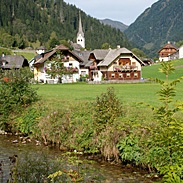 Muhr
Muhr
A tiny village in the Lungau area of Salzburg state, in the greenest of valleys (near alpine lakes) and lying beneath the imposing 3,076m Hafner mountain. Muhr has direct access to the National Park Hohe Tauern, and on foot to the source of the River Mur. At the end of June, a famous custom takes place where 6m tall poles are decorated with alpine flowers and processed to the local church. The ‘Prangenstangen’ remain in the church until
mid-August. This is also one of the villages in the Murtal which holds a ‘Samson procession of the giants’.
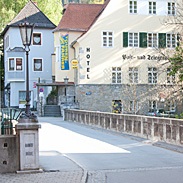 Murau
Murau
Surrounded by the Lower Tauern and Nock mountains, this historic village on the River Mur, 829m above sea level in the Styrian alps allegedly has the healthiest air in Austria! The medieval town centre is small, retaining parts of the city wall. The brewery museum, Schillerplatz, and the fine 13th C. castle, Schloss Obermurau are a must – so too the 14th C. frescoes at St. Annakirche and St. Matthäuskirche; the latter also has a haunting charnel house. Local traditions are important here and the village holds an annual ‘Samson procession of the giants’.
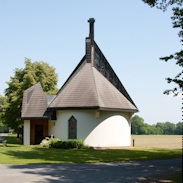 Mureck
Mureck
Near to Styria’s famed wine route, close to the Slovenian border and set in reputedly the second largest wooded area in Austria, this little village has a charming orange and white town hall with a six-storey tower and rare and intact Baroque clock chime.
12th C. St. Bartholomäu’s Church has been restored to Baroque splendour. There is a rare watermill or ‘Ship mill’ here on the River Mur – of wooden construction and with a thatched roof, the restored mill house and wheel which grinds corn sits somewhat precariously at the end of a jetty away from the river bank.
Oberaich
On the River Mur close to the Madereck and Mugler mountains in the Hochsteierkmark/Styria region, this gentle village is surrounded by woods and meadows. There are great views from St. Dionysen’s church which also has ancient altar stone to Hercules Augustus in its graveyard. St. Ulrich’s Church on the other side of the Mur is also worth a visit, so too the village’s picturesque Roman bridge.
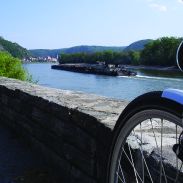 Perg
Perg
Originally part of the Duchy of Bavaria, the town became part of Austria in the 12th C. It’s best known landmark is the little, late Baroque Church of the Calvary Hill (or Kalvarienbergkirche).
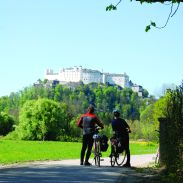 Salzburg
Salzburg
Mozart’s native city has to be one of Austria’s most beautiful and inspirational. The old town is included in the UNESCO World Heritage list, and is perhaps the best preserved of city centres north of the Alps. Baroque architecture steals the show here, and the mountain location along with the views from the fortress Hohensalzburg which sits on the rocks high above the old town, makes it a unique destination (as well as a remarkable film set for ‘The Sound of Music’). The Mirabell Gardens, the cathedral, Nonnberg Abbey, the former Prince-Archibishop’s palace and the palaces/castles at Hellbrunn and Leopoldskron are great attractions, but Mozart’s house and birthplace in the historic Getreidegasse are at the top of most visitors’ must-see list.
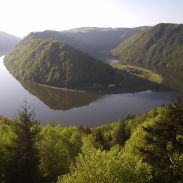 Schlogen
Schlogen
The place to see an oxbow lake in the making. This is where the Danube does a very picturesque loop and geography lesson memories just can’t help flooding back. Boat cruises and the
Au-Schlogen bike ferry are based at the shipping pier here.
Seeham
A small village, just 20km north of Salzburg, situated on the Obertrummer See – a picturesque and lesser-known lake.
St. Gilgen
Situated on the south-western shore of Lake Wolfgangsee in the Austrian Lake District, this is a popular little resort from which to take a boat trip out on the lake to see the towns and villages which nestle on the shores beneath the mountains.
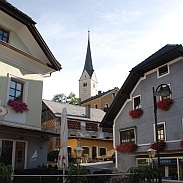 St. Michael im Lungau
St. Michael im Lungau
1,075 metres above sea level and backed by the Tauern mountains, this beautiful village of traditional wooden chalets and churches with finger-thin towers and curvaceous cupolas is a firm winter favourite with cross country skiers. Situated on the River Mur in the Tamsweg district of Salzburg state, it accesses the Katschberg and Obertauern mountain network of ski routes, but the place really blossoms in summer. It is renowned for its traditional festivals including the ‘Samson Procession of the Giants’ which takes place around Corpus Christi and for its popular championship golf course.
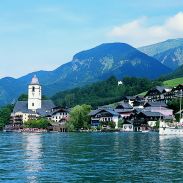 St. Wolfgang
St. Wolfgang
At the foot of Mount Schafberg on the northern shore of Lake Wolfgangsee, this pretty little town has been a health resort since the late 19th C. In the winter, it dedicates itself to skiing. Creeper-clad houses with geranium-filled window boxes line narrow lanes of shops and cafés – the White Horse Inn (or Hotel Weisses Rössl) is famous as a setting for a musical comedy. Take the rack railway (Schafbergbahn) up the mountain for great views of the lake and its surrounding mountains.
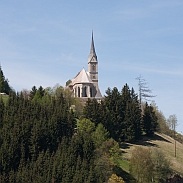 Tamsweg
Tamsweg
The administrative and commercial centre of the Lungau area in Salzburg state – Tamsweg sits 1,024m above sea level on the River Mur. It has a neat historic centre with smart colourful houses around a lively market place and is famous for its
15th C. Pilgrimage Church of St. Leonhard with its striking golden window. Tradition is important here: a narrow gauge railway offers a nostalgia trip between Tamsweg and Murau, and the village’s 6m tall processional giant ‘Samson’ can be visited at the Heimatsmuseum. Tamsweg also has an intriguing traditional water target shooting festival at the nearby Prebersee.
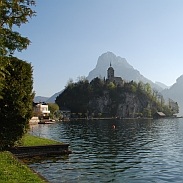 Traunkirchen
Traunkirchen
A small village on the Traunsee lake in the Salzkammergut, loved for its vistas of the parish church against the mountains. Inside is a carved pulpit called the Fischerkanzel or fisherman’s pulpit.
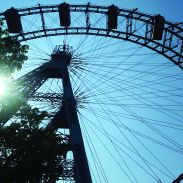 Vienna (Wien)
Vienna (Wien)
Austria’s capital, famed for its opera, waltzing musical history and famous Schnitzel (veal cutlets) is bursting with culture and great places to visit. As well as the imperial palaces of Hofburg and Schönbrunn, there are architectural delights from the Romanesque Ruprechtskirche or Baroque Karlskirche to art nouveau legacies and the wackiness of the Hundertwasserhaus. A trip on the famous big wheel (Riesenrad) at the Wiener Prater gives great views over the city. When it comes to museums, the Naturhistoricshes Museum is particularly impressive, but then there are over 100 art museums to choose from, plus popular sites associated with composers such as Beethoven and Mozart. The historic coffee houses are a real treat, the smart place to relax and delight in traditional Kaffee und Kuchen – afternoon coffee with a slice of Sachertorte or local apple strudel.





